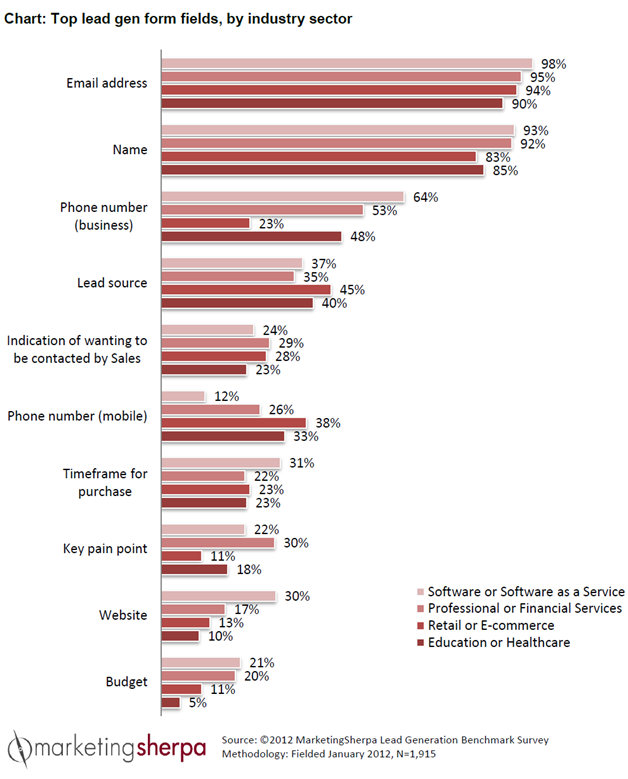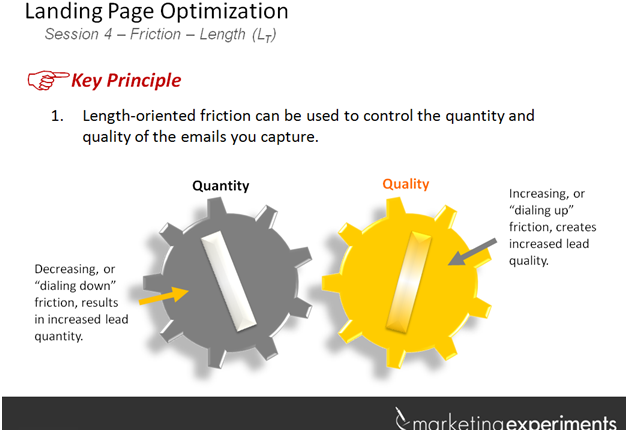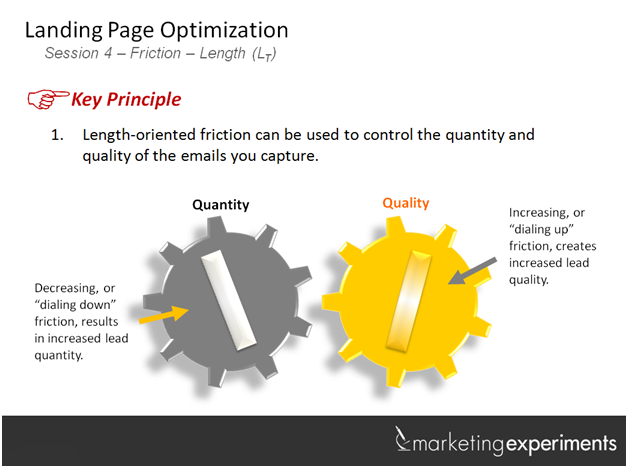Friction on your lead generation landing pages is bad, because it reduces conversions.
Except that is not always a bad thing. Hear me out for a moment …
As we teach in the MarketingExperiments Landing Page Optimization Online Course, you’re certainly not looking to eliminate friction. When it comes to lead generation, you’re not even always looking to reduce friction … what you’re looking for is the right balance that ultimately makes your company more profitable.
This might seem counterintuitive at first, especially if you work in a marketing department that has a relentless focus on only one number – the amount of leads generated.
However, high-quality leads will likely result in less dead ends for the sales force. Thus, Sales will invest more of its time on leads more apt to close, which should make everyone happier at the end of the day.
Use the lead gen dials to flexibly optimize your page
But you don’t have to be locked into only one approach. The great thing about the lead gen dial approach (shown in the image above) is that it can help you flexibly adapt to your company’s needs:
-
- If your sales force is simply starved for leads, you can reduce friction to increase the number of leads they receive.
-
- If your sales force has a long list of leads they still haven’t contacted, you can dial up friction to reduce the overall number of leads, but acquire higher-quality leads that go straight to Sales with a clear priority attached in them.
Of course, if you work in the marketing department, these changes shouldn’t happen in a vacuum. You should create a flexible universal lead definition with Sales that can adapt and scale as the company’s needs change.
Friction in lead generation forms
One of the most impactful places to adjust friction is in the lead gen form itself. Here are three places you can adjust friction, and then test to see which combination is most profitable for your company:
- Make some form fields optional. If you use this technique, very motivated leads can choose to give more information, but you hypothetically wouldn’t lose any less motivated leads, since they wouldn’t have to fill out those form fields.
A word of caution, though — a long form presents a large amount of perceived friction. Let’s face it, even with optional fields, a long form just looks time-consuming in the split second a prospect decides whether to act or not.
- Use a two-step process. You can capture basic information, and then ask for more in-depth information in a second step. You can test offering an incentive for completion of the more time-consuming second step, or just clearly communicate the benefit to the prospect (for example, that they will receive more relevant information from your company).
For leads that don’t complete the second step, you can follow up and try to gain more information at a later date (when they might be further along in the buying cycle, and, therefore, more motivated to provide that information).
- Simply remove form fields. Take a good hard look at your form and sit down with every person or department that has an interest in that form. For example, does Job Title or Budget really help Sales? If so, it might be worth keeping.
If not, it may be like the appendix, a vestigial form field that had a good purpose in a previous era, but no one currently at the company remembers why exactly they needed that information.
To help you in your lead generation form field testing, here is a look at the most important form fields, as told to us by the 1,915 marketers surveyed for the MarketingSherpa 2012 Lead Generation Benchmark Report (free excerpt at that link):

Updated November 22, 2021
When writing an article like this, it is so hard to know how deep to get. Really, this topic calls for hundreds of thousands, if not millions, of words. Not practical, of course.
However, after reading an article that was published in response, I thought it worthwhile to go a little deeper, and add a few more points.
Lead qualification is an effective tactic that can be helpful if your sales force is unable to follow up with all of the leads you are generating (or even if the sales force does have capacity. If you are unfamiliar with lead qualification, this article might help – Intro to Lead Generation: How to determine if a lead is qualified.
Shorter forms don’t necessarily generate lower-quality leads. But they do tend to generate a larger amount of leads than a longer form, and in that volume, there are certainly many lower-quality, and certainly less motivated, leads. And for marketers who don’t have lead qualification in place (according to our MarketingSherpa research, an astounding 61% of B2B marketers admit to sending “leads” directly to Sales without qualification), having a better understanding of landing page friction is a way (certainly not the only way) to more profitably generate leads.
In the end, the biggest point I was trying to make with the article is, “But you don’t have to be locked into only one approach.” Getting someone, even many people, to fill out a lead form is not a sure path to profitable lead generation. So I wanted to challenge marketers’ lead generation assumptions.
Lead qualification is a path down that road.
But when it comes to forms, there is no one-size fits all solution. Sometimes shorter forms are more effective to total profitability, some situations call for longer forms, and sometimes, dare I say, it might be best to have no form at all.
Related Resources:
Lead Generation: Testing form field length reduces cost-per-lead by $10.66
Landing Page Optimization: Test ideas for a B2B lead capture page
Form Optimization: 3 case studies to help convince your boss (and Sales) to reduce form fields





This is really interesting information on lead generation, it’s certainly a key field in business marketing nowadays